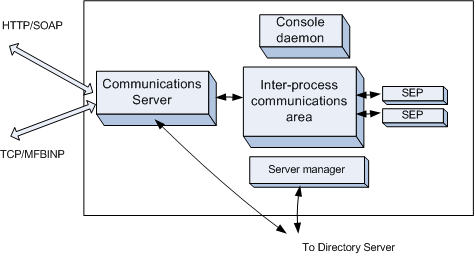Enterprise Server Instance Architecture
The following figure shows a high-level view of the enterprise server instance architecture and components.

An enterprise server instance consists of some processes and an area used for inter-process communication.
As the COBOL applications run within their own address spaces, they are isolated from other programs executed within the enterprise server instance. Multiple execution processes enable concurrent processing of COBOL programs responding to client request messages.
The instance processes include a console daemon, server manager and communications process. These processes provide the following functionality:
- The console daemon manages enterprise server instance processes and logs messages.
- The server manager creates and manages the inter-process communication area and works in conjunction with the console daemon to provide process management.
- The communications process receives incoming client requests and forwards them on to the appropriate services. It also receives
the output from the request processing and sends it back to the clients. The requests can come from the following types of
client:
- Clients requesting a Web service. Requests from these clients arrive over HTTP as SOAP (Simple Object Access Protocol) messages.
- J2EE clients requesting a service. Requests from J2EE clients arrive using a Micro Focus encoding and transport protocol.
All types of requests use TCP/IP as the underlying communications mechanism.
An enterprise server instance is created with one communications process, but you can add more to improve reliability and fault tolerance.
An enterprise server instance is created with two service execution processes (SEPs). A SEP is the process that actually executes the COBOL program that handles the client request. You can add more SEPs if the processing load requires it.
The inter-process communication area consists of a shared memory area that contains definitions of all the services that are available within the enterprise server instance. These definitions are located on the Directory Server. It sits outside the enterprise server instance, and can contain information for the enterprise server instances running in your installation. The inter-process communication area is also used to pass requests and responses between the enterprise server instance processes.